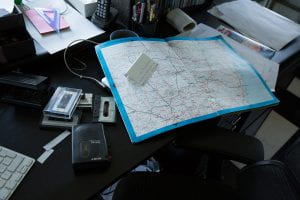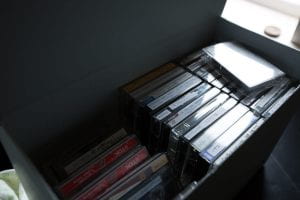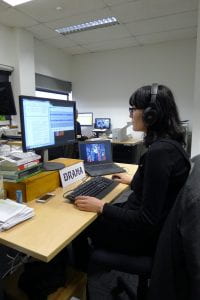
‘Well, hello machine’: Timecoding audio in the Germaine Greer Archive
by Kate Hodgetts, Audio Cataloguer
Imagine that you are a passenger in a car. The car is being driven through the British countryside. Your driver, Germaine Greer, tells you that this is her ‘Favourite road in all the world,’ and proceeds to describe the landscape in vivid, colourful detail. ‘It’s sort of dull and burnished, and rich as can be, all covered with this sort of Rembrandt brown varnish’… ‘The sky is a kind of lilac grey, quite luminous. But the land is sucking in the light.’
Later, that same voice whispers observations of life and death and you are transported to a refugee camp in Ethiopia during the famine of 1984–1985.
From here, who knows where…?

The audio series in the Germaine Greer Archive is richly diverse and invites listeners to enter into intimate, domestic moments in Greer’s life. From walking her beloved poodles Molly and Margot through the Essex country side to travelling across the Nullarbor aboard the Indian Pacific Rail Service, Greer has carried her trusty voice recorder. Sometimes she reports on what she has seen, thought, or experienced; other times she simply documents her days.
The University of Melbourne Archives (UMA) acquired the personal and professional archive of author and academic Germaine Greer in 2014. It now occupies 80 metres of shelf space in the repository. Part of this archive is 150 hours of audio recordings.
A few of the recordings are on digital audio tapes and mini discs but most are on cassette and were recorded, by Greer, directly to her voice recorder. The series (2014.0040) dates from as early as 1971, and contains diaries and travelogues, recorded in the UK, Australia, Poland, Cuba, Ethiopia and elsewhere; and interviews, lectures and radio appearances. The series includes three interviews that Greer conducted in Italian with Primo Levi (1985), Federico Fellini (1988) and Luciano Pavarotti (1991). UMA Archivist Sebastian Gurciullo has time-coded these conversations, in English and Italian. The publications that resulted from these conversations are listed in the print series (2014.0046).

Archivists are listening to digitised versions of the recordings. University Archivist Katrina Dean had the records digitised in the United Kingdom in 2014. The creation of both preservation masters and access duplicates meant that audio files could be remastered in order to improve sound quality and accessibility without altering the original recording.
The Greer Archive also contains some home movies and these records have also been digitised. The Greer material was included in Audiovisual Archivist Emma Hyde’s audit of the UMA audiovisual collection.
In early 2016, Assistant Archivist Millie Weber developed time-coding procedures and UMA Archivists coded a pilot selection of Greer’s recordings, including a telephone machine answering tape from 1976.
Since July, I have been working full time on cataloguing the 150 hours of material. It’s the first time that audio material has been documented so thoroughly at UMA and much of the work undertaken within the Greer Archive will eventually be adapted to document other collections.
Like transcripts, time-coded summaries work as a finding tool to search through content, enabling researchers to quickly determine whether a recording is relevant to their work. They describe short segments of audio, providing a quick guide to themes and topics discussed within the recording. The short summaries are kept succinct and direct and keywords are included to highlight potential topics of interest that may not be explicitly explained in the description.
The team working on the Greer Archive are developing a thesaurus of subject headings. Some are Library of Congress Subject Headings and others, such as the titles of Greer’s many books, are specific to this collection.

The uniqueness of the audio series within the Greer Archive and the inclusion of Greer’s audio diaries have meant that these succinct and direct summaries are humanised, and often humorous, inspiring, controversial, and colourful. Even the more formal formats of lectures and interviews hint at the character more dramatically exposed in the audio diaries.
Listening to these recordings through head phones is a privileged experience. Most of the recordings were captured by Greer with her own voice and with her own fingers pressing record, then pause, and then record again. Though digitised copies, the original aesthetic of the hand held recordings remain. Greer often wrestles with the voice recorder in an attempt to get it to capture what she wants, like the sound of the raging sea off the coast of Western Australia. ‘Can you hear the sea?’ she asks. ‘I don’t think you can hear the sea because when I am not talking to you, you turn yourself off.’ Having the recorder set to voice activation means that the sound of the crashing waves is fragmented and juxtaposed with Greer’s voice. The result is spontaneous and poetic.

Listening through the Greer audio we are invited to travel through the everyday with Greer, sitting in on lectures, conversations, and car trips, and through these recordings we are able to gain a greater understanding of her life and work. While significant, unique and rich with research potential, until preserved and digitised by UMA all of these recordings were contained within old audio cassettes, not far from their life expectancy (which is up to 30 years). The significance and uniqueness of this collection highlights the urgency of preservation plans within audiovisual collections. For without proper documentation, preservation and digitisation these materials may have been, in the words of Greer, fumbling with her recorder, ‘lost to posterity.’
The audio series is still being catalogued and processed along with the rest of the collection. The archive will be open to researchers from 27 March 2017. I will be one of the speakers at the ‘Meet the Greer Archivist’ event to be held on International Women’s Day, 8 March 2017.
For more information on the Germaine Greer collection, archive project and online resources please visit the Germaine Greer collection webiste
October 27 celebrates World Day for Audiovisual Heritage. Dedicated by UNESCO, the day aims to increase awareness of the importance of audiovisual materials and to highlight the urgent need for preservation and digitisation. “It’s your story – don’t lose it ” is the theme of this year’s celebration.
Leave a Reply